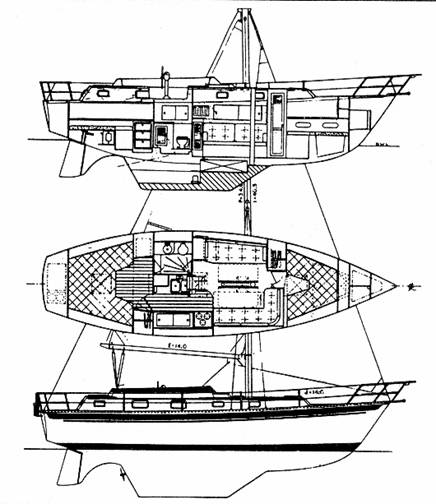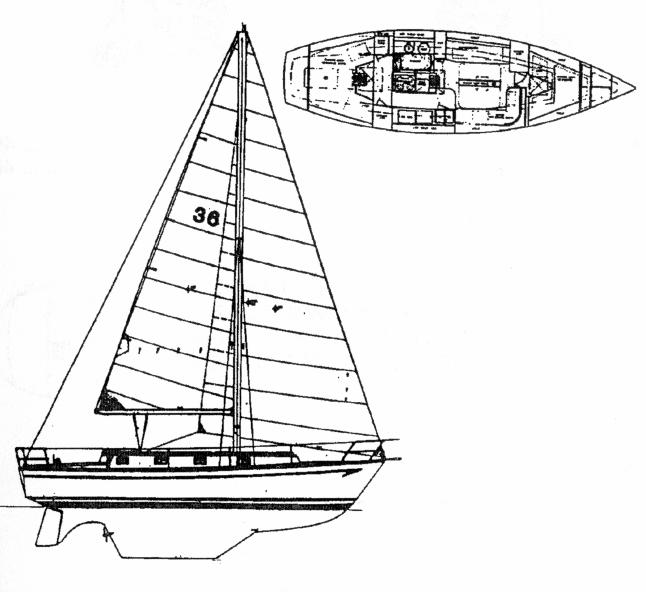|
D E S I G N & H I S T O R Y The W36 was first introduced in 1978 as a Portman 36 aft cockpit sloop, but after only one or two hulls were built, the business was merged with Watkins Yachts and became the W36. In 1981 the center cockpit model was added and although both models were built for a while production of the aft version soon ceased. Production of the center cockpit version ceased with the 1986 model year. Production was very low with less than 60 total boats of both types being built. Hull # 57 was built in 1982 and hull # 58 was built in 1984. The history page contains some interesting antidotal information on how this model came into being. The boat is sloop rigged with a 46 draft and a skeg mounted rudder. Standard items includes diesel engine, pressure water, shower, twelve opening ports, folding dining table and shore power. Headroom is 63 and her mast height above DWL is 45 feet. Both versions use the same interior layout with the owners stateroom aft, with head entrance both from stateroom and salon. The galley is located in the passageway and includes a double sink, 12 volt refrigeration and 3 burner stove with oven. |
|
SPECIFICATIONS
LOA . ....360 DWL . . ...290 Beam . ..106 Draft . .. .46 Disp. ...17,000 lbs. Ballast .6,000 lbs. Sail Area .526 sq. ft. Fuel ...40 gal. Water .85 gal. Mast Height above DWL .....45 Headroom ....63 Min Designer ..Watkins Brothers |

|
W36C |

|
SPECIFICATIONS
LOA . ....360 DWL . . ...294 Beam . ..106 Draft . .. .46 Disp. ...17,000 lbs. Ballast .6,000 lbs. Sail Area .526 sq. ft. Fuel ...40 gal. Water .60 gal. Mast Height above DWL .....45 Designer ..Watkins Brothers |
|
W36AC |
H U L L & D E C KThe hull is molded as a single unit of a combination of polyester resin and fiberglass woven roving and multidirectional chopped strand fiber (MCSF). The keel is molded integrally with the hull and all ballast is contained inside. The deck and cockpit, like the hull, are molded as a single unit of a combination of polyester resin and fiberglass woven roving and MCSF. Plywood coring is incorporated between layers of fiberglass in the cabin top, deck, seat, and cockpit sole areas to give additional stiffness. The non-skid finish is molded into the deck. The exterior finish is pigmented gelcoat molded onto the fiberglass. The boot stripe is also tinted gelcoat molded permanently into the hull. R U D D E R & S T E E R I N GThe rudder is made by Foss Foam, molded as two fiberglass halves, the hollow stainless steal rudder post welded to blades is placed inside and the assembly is filled with a high density foam. The rudder is mounted to a full skeg for strength. S P A R S & R I G G I N GAll spars (mast, boom, and spreaders) are extruded aluminum 6061-T6 alloy, with a protective coating an all external surfaces. The masts has a single spreader, and booms with single reefing. After 1984 the mast and boom were made by Isomat. The main sheet traveler is mounted on the cabin top. Two dual speed winches control the genoa sheets. I N T E R I O RThe interior is a molded fiberglass unit with bulkheads and cabinetry fastened to it with screws, bolts, and adhesives. The interior molded assembly is bonded to the hull with woven roving and mat, that when completed, forms a single unit structure having great strength and rigidity. The headliner is made of soft perforated vinyl with teak trim. The interior is finished with hand rubbed teak accents and the bulkheads and cabinetry is teak veneered plywood. Early models had a carpeted cabin sole but later models were teak and holly veneered plywood. The interior layout is typical with a V-berth forward, the head is aft and connects to both the salon and the owners stateroom. The galley is aft in the passageway to the owners state room. The galley is equipped with refrigerator, 3 or 4 burner propane stove with eye level oven and double sink. The stairs removes to allow access to the engine on the center cockpit model or tilts up on the AC model. A U X I L A R YA 40 horse power Perkins diesel engine was standard equipment on the early models with a Perkins 50 horse power model #4108 on the later models.. E L E C T R I C A L .S Y S T E M Standard configuration unknown Last updated 04/22/2007
|
|
W A T K I N S W 3 6 A C / W 3 6 C |